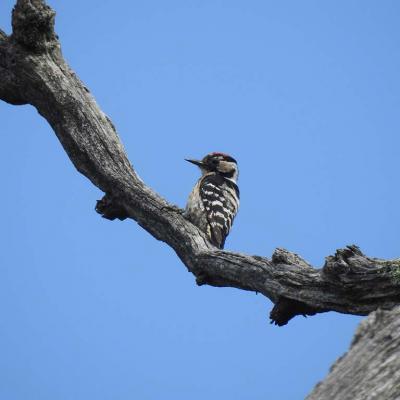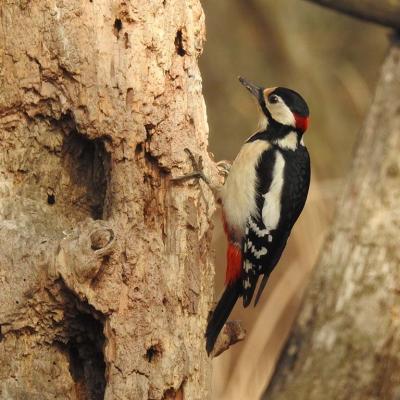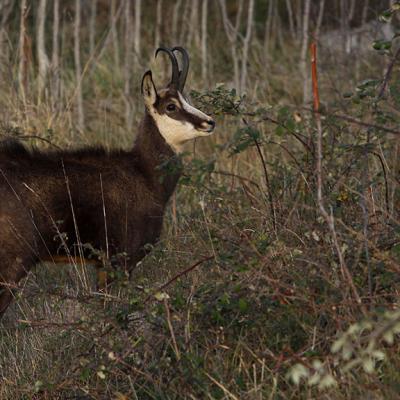Faunal monitoring is an essential part of the work that takes place within the nature reserve as it allows to define the distribution and conservation status of the species that live in it. Some species are also imported indicators that make it possible to understand the environmental changes in progress and to evaluate the results of the management interventions that are intended to be carried out. For these reasons, a monitoring plan was developed with appropriate methodologies for the main groups of species present in the Reserve area, focusing to date essentially on vertebrates. The monitoring is conducted annually and the collected data are transmitted to the municipal administration and are summarized in reports available here.
The Reserve has an extremely rich and diverse bird community, a consequence of a high environmental heterogeneity (bush, heath, cliffs, wetlands, agricultural areas). The lakes are home to different species of birds, some nesting, such as the coot (Fulica atra) and the moorhen (Gallinula chloropus), others parked during migratory movements, such as the gadwall (Anas strepera), the teal (Anas crecca), the pochard (Aythya ferina) and the tufted duck (Aythya fuligula). In the open areas some pairs of tottavilla (Lullula arborea) and the increasingly rare have small nest (Lanius collurio), while the nightingale (Luscinia megarhynchos) is very abundant in the bush and there are some pairs of nightjar (Caprimulgus europaeus). The hygrophilous woods around Lake Doberdò are the best in Italy for the number of species of woodpeckers, there are in fact 7 species, of which 6 nesting: the lesser spotted woodpecker (Dryobates minor) and greater (Dendrocopos major), the woodpecker green (Picus viridis) and gray (Picus canus), the stiff neck (Jynx torquilla) and the black woodpecker (Dryocopus martius), the largest woodpecker in Europe, the size of a crow. The spotted woodpecker (Dendrocopos medius) is present but does not nest. There are also the common treecreeper (Certhia brachydactyla) and the nuthatch (Sitta europaea).
The reptiles are well represented within the Reserve, and are easily observed at certain times of the year along the paths, on the cliffs and grizes, at the edge of the forest.
A peculiarity of the nature reserve is represented by the presence of chamois (Rupicapra rupicapra). There is a small population of chamois present in the Castellazzo area, albeit of modest size (probably 10-12 stable individuals). The herd is currently made up of 4 adult females plus 1 or two younger females and the youngest of the year and is led by an elderly female. During the mating period (November) also males appear, usually one always present, occasionally three different individuals have also been observed. Other individuals probably frequent other areas of the Reserve that have not yet been investigated (Debeli), and chamois have often been observed outside the limits of the protected area on the rocky emergencies overlooking the town of Ronchi dei Legionari and the highway.
Tesi
La collaborazione con l'Università degli studi di Trieste (referente prof. Alfredo Altobelli) ha portato alla realizzazione di diverse tesi incentrate sulla flora della Riserva.
• Anno accademico 2017-2018, Università degli Studi di Pavia, Dipartimento di Scienze della Terra e dell'Ambiente, Corso di Laurea Magistrale in Scienze della Natura, “Sovrapposizione di nicchia tra sciacallo dorato (Canis aureus) e volpe (Vulpes vulpes) in un’area di simpatria nell’Italia nord-orientale (Carso goriziano)”, Laureanda Elena Costa, Relatore Francesco Nonnis Marzano, Correlatori Alberto Meriggi, Elisa Torretta
• Anno accademico 2017-2018, Università degli Studi di Pavia, Dipartimento di Scienze della Terra e dell'Ambiente, Corso di Laurea Magistrale in Scienze della Natura, FATTORI INFLUENZANTI LA DISTRIBUZIONE DELLO SCIACALLO DORATO (Canis aureus) IN FRIULI VENEZIA GIULIA, Laureando Claudio Delfoco, Elena Costa, Relatore Alberto Meriggi, Correlatrice Elisa Torretta
• Anno Accademico 2017-2018, Università degli Studi di Trieste, Dipartimento di Scienze della Vita, Corso di Laurea triennale in Scienze e Tecnologie per l’Ambiente e la Natura, "Monitoraggio delle specie presenti nella Riserva Naturale dei Laghi di Doberdò e Pietrarossa come strumento per valutare lo stato di conservazione della biodiversità", Laureanda Alice Musina, Relatore Alfredo Altobelli, Correlatore Tina Klanjšček
• Anno Accademico 2017-2018, Università degli Studi di Pavia, Dipartimento di Scienze della Terra e dell'Ambiente, Corso di Laurea Magistrale in Scienze della Natura, "Interazioni interspecifiche tra sciacallo dorato (Canis aureus Linneaus, 1758) e volpe (Vulpes vulpes Linneaus, 1758) nell'Italia nord-orientale", Laureando Luca Riboldi, Relatore Alberto Meriggi, Correlatrice Elisa Torretta
• Anno Accademico 2017-2018, Università degli Studi di Trieste, Dipartimento di Scienze della Vita, Corso di Laurea magistrale in Ecologia dei cambiamenti globali, "Stima della consistenza e della distribuzione della popolazione di camoscio alpino (Rupicapra rupicapra L.) nella Riserva Naturale dei Laghi di Doberdò e Pietrarossa (Friuli-Venezia Giulia, Italia) ", Laureanda Martina Felician, Relatore Elisabetta Pizzul, Correlatore Matteo De Luca
• Anno Accademico 2014-2015, Università degli Studi di Trieste, Dipartimento di Scienze della Vita, Corso di Laurea triennale in Scienze e Tecnologie per l’Ambiente e la Natura, "Analisi storica dei cambiamenti ambientali della zona umida dei Laghi di Doberdò, Pietrarossa, Sablici e Mucille", Laureando Damir Grieco, Relatore Alfredo Altobelli, Correlatori Miris Castello, Luis Daniele
• Ljubljana 2013, Univerza v Ljubljani, Biotehniška fakulteta, "Pogostost in zastopanost izbranih invazivnih tujerodnih rastlinskih vrst v okolici Doberdobskega jezera (The abundance and presence of selected alien invasive plant species in the surroundings of the Doberdò lake)", laureanda Sara Visintin






























































